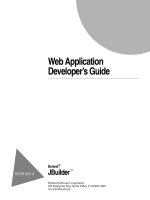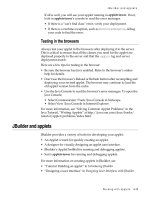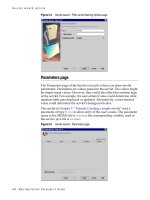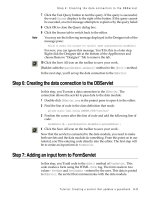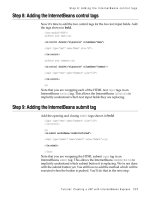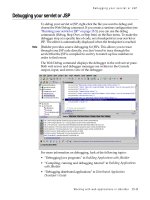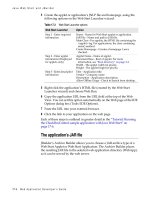ARM System Developer’s Guide phần 3 docx
Bạn đang xem bản rút gọn của tài liệu. Xem và tải ngay bản đầy đủ của tài liệu tại đây (457.3 KB, 70 trang )
128 Chapter 5 Efficient C Programming
In this case the second value of *step is different from the first and has the value *timer1.
This forces the compiler to insert an extra load instruction.
The same problem occurs if you use structure accesses rather than direct pointer access.
The following code also compiles inefficiently:
typedef struct {int step;} State;
typedef struct {int timer1, timer2;} Timers;
void timers_v2(State *state, Timers *timers)
{
timers
-
>timer1 += state
-
>step;
timers
-
>timer2 += state
-
>step;
}
The compiler evaluates state
-
>step twice in case state
-
>step and timers
-
>timer1 are
at the same memory address. The fix is easy: Create a new local variable to hold the value
of state
-
>step so the compiler only performs a single load.
Example
5.8
In the code for timers_v3 we use a local variable step to hold the value of state
-
>step.
Now the compiler does not need to worry that state may alias with timers.
void timers_v3(State *state, Timers *timers)
{
int step = state
-
>step;
timers
-
>timer1 += step;
timers
-
>timer2 += step;
}
■
You must also be careful of other, less obvious situations where aliasing may occur.
When you call another function, this function may alter the state of memory and so change
the values of any expressions involving memory reads. The compiler will evaluate the
expressions again. For example suppose you read state
-
>step, call a function and then
read state
-
>step again. The compiler must assume that the function could change the
value of state
-
>step in memory. Therefore it will perform two reads, rather than reusing
the first value it read for state
-
>step.
Another pitfall is to take the address of a local variable. Once you do this, the variable is
referenced by a pointer and so aliasing can occur with other pointers. The compiler is likely
to keep reading the variable from the stack in case aliasing occurs. Consider the following
example, which reads and then checksums a data packet:
int checksum_next_packet(void)
{
int *data;
int N, sum=0;
5.6 Pointer Aliasing 129
data = get_next_packet(&N);
do
{
sum += *(data++);
} while ( N);
return sum;
}
Here get_next_packet is a function returning the address and size of the next data packet.
The previous code compiles to
checksum_next_packet
STMFD r13!,{r4,r14} ; save r4, lr on the stack
SUB r13,r13,#8 ; create two stacked variables
ADD r0,r13,#4 ; r0 = &N, N stacked
MOV r4,#0 ; sum = 0
BL get_next_packet ; r0 = data
checksum_loop
LDR r1,[r0],#4 ; r1 = *(data++)
ADD r4,r1,r4 ; sum += r1
LDR r1,[r13,#4] ; r1 = N (read from stack)
SUBS r1,r1,#1 ; r1 & set flags
STR r1,[r13,#4] ;N=r1(write to stack)
BNE checksum_loop ; if (N!=0) goto loop
MOV r0,r4 ; r0 = sum
ADD r13,r13,#8 ; delete stacked variables
LDMFD r13!,{r4,pc} ; return r0
Note how the compiler reads and writes N from the stack for every N Once you
take the address of N and pass it to get_next_packet, the compiler needs to worry about
aliasing because the pointers data and &N may alias. To avoid this, don’t take the address
of local variables. If you must do this, then copy the value into another local variable
before use.
You may wonder why the compiler makes room for two stacked variables when it only
uses one. This is to keep the stack eight-byte aligned, which is required for LDRD instructions
available in ARMv5TE. The example above doesn’t actually use an LDRD, but the compiler
does not know whether get_next_packet will use this instruction.
130 Chapter 5 Efficient C Programming
Summary Avoiding Pointer Aliasing
■
Do not rely on the compiler to eliminate common subexpressions involving memory
accesses. Instead create new local variables to hold the expression. This ensures the
expression is evaluated only once.
■
Avoid taking the address of local variables. The variable may be inefficient to access
from then on.
5.7 Structure Arrangement
The way you lay out a frequently used structure can have a significant impact on its perfor-
mance and code density. There are two issues concerning structures on the ARM: alignment
of the structure entries and the overall size of the structure.
For architectures up to and including ARMv5TE, load and store instructions are only
guaranteed to load and store values with address aligned to the size of the access width.
Table 5.4 summarizes these restrictions.
For this reason, ARM compilers will automatically align the start address of a structure
to a multiple of the largest access width used within the structure (usually four or eight
bytes) and align entries within structures to their access width by inserting padding.
For example, consider the structure
struct {
char a;
int b;
char c;
short d;
}
For a little-endian memory system the compiler will lay this out adding padding to ensure
that the next object is aligned to the size of that object:
Address +3 +2 +1 +0
+0 pad pad pad a
+4 b[31,24] b[23,16] b[15,8] b[7,0]
+8 d[15,8] d[7,0] pad c
Table 5.4 Load and store alignment restrictions for ARMv5TE.
Transfer size Instruction Byte address
1 byte LDRB, LDRSB, STRB any byte address alignment
2 bytes LDRH, LDRSH, STRH multiple of 2 bytes
4 bytes LDR, STR multiple of 4 bytes
8 bytes LDRD, STRD multiple of 8 bytes
5.7 Structure Arrangement 131
To improve the memory usage, you should reorder the elements
struct {
char a;
char c;
short d;
int b;
}
This reduces the structure size from 12 bytes to 8 bytes, with the following new layout:
Address +3 +2 +1 +0
+0 d[15,8] d[7,0] c a
+4 b[31,24] b[23,16] b[15,8] b[7,0]
Therefore, it is a good idea to group structure elements of the same size, so that the
structure layout doesn’t contain unnecessary padding. The armcc compiler does include
a keyword __packed that removes all padding. For example, the structure
__packed struct {
char a;
int b;
char c;
short d;
}
will be laid out in memory as
Address +3 +2 +1 +0
+0 b[23,16] b[15,8] b[7,0] a
+4 d[15,8] d[7,0] c b[31,24]
However, packed structures are slow and inefficient to access. The compiler emulates
unaligned load and store operations by using several aligned accesses with data operations
to merge the results. Only use the __packed keyword where space is far more important
than speed and you can’t reduce padding by rearragement. Also use it for porting code that
assumes a certain structure layout in memory.
The exact layout of a structure in memory may depend on the compiler vendor and
compiler version you use. In API (Application Programmer Interface) definitions it is often
132 Chapter 5 Efficient C Programming
a good idea to insert any padding that you cannot get rid of into the structure manually.
This way the structure layout is not ambiguous. It is easier to link code between compiler
versions and compiler vendors if you stick to unambiguous structures.
Another point of ambiguity is enum. Different compilers use different sizes for an enu-
merated type, depending on the range of the enumeration. For example, consider the type
typedef enum {
FALSE,
TRUE
} Bool;
The armcc in ADS1.1 will treat Bool as a one-byte type as it only uses the values 0 and 1.
Bool will only take up 8 bits of space in a structure. However, gcc will treat Bool as a word
and take up 32 bits of space in a structure. To avoid ambiguity it is best to avoid using enum
types in structures used in the API to your code.
Another consideration is the size of the structure and the offsets of elements within the
structure. This problem is most acute when you are compiling for the Thumb instruction
set. Thumb instructions are only 16 bits wide and so only allow for small element offsets
from a structure base pointer. Table 5.5 shows the load and store base register offsets
available in Thumb.
Therefore the compiler can only access an 8-bit structure element with a single instruc-
tion if it appears within the first 32 bytes of the structure. Similarly, single instructions can
only access 16-bit values in the first 64 bytes and 32-bit values in the first 128 bytes. Once
you exceed these limits, structure accesses become inefficient.
The following rules generate a structure with the elements packed for maximum
efficiency:
■
Place all 8-bit elements at the start of the structure.
■
Place all 16-bit elements next, then 32-bit, then 64-bit.
■
Place all arrays and larger elements at the end of the structure.
■
If the structure is too big for a single instruction to access all the elements, then group
the elements into substructures. The compiler can maintain pointers to the individual
substructures.
Table 5.5 Thumb load and store offsets.
Instructions Offset available from the base register
LDRB, LDRSB, STRB 0 to 31 bytes
LDRH, LDRSH, STRH 0 to 31 halfwords (0 to 62 bytes)
LDR, STR 0 to 31 words (0 to 124 bytes)
5.8 Bit-fields 133
Summary Efficient Structure Arrangement
■
Lay structures out in order of increasing element size. Start the structure with the
smallest elements and finish with the largest.
■
Avoid very large structures. Instead use a hierarchy of smaller structures.
■
For portability, manually add padding (that would appear implicitly) into API
structures so that the layout of the structure does not depend on the compiler.
■
Beware of using enum types in API structures. The size of an enum type is compiler
dependent.
5.8 Bit-fields
Bit-fields are probably the least standardized part of the ANSI C specification. The compiler
can choose how bits are allocated within the bit-field container. For this reason alone, avoid
using bit-fields inside a union or in an API structure definition. Different compilers can
assign the same bit-field different bit positions in the container.
It is also a good idea to avoid bit-fields for efficiency. Bit-fields are structure ele-
ments and usually accessed using structure pointers; consequently, they suffer from the
pointer aliasing problems described in Section 5.6. Every bit-field access is really a memory
access. Possible pointer aliasing often forces the compiler to reload the bit-field several
times.
The following example, dostages_v1, illustrates this problem. It also shows that
compilers do not tend to optimize bit-field testing very well.
void dostageA(void);
void dostageB(void);
void dostageC(void);
typedef struct {
unsigned int stageA : 1;
unsigned int stageB : 1;
unsigned int stageC : 1;
} Stages_v1;
void dostages_v1(Stages_v1 *stages)
{
if (stages
-
>stageA)
{
dostageA();
}
134 Chapter 5 Efficient C Programming
if (stages
-
>stageB)
{
dostageB();
}
if (stages
-
>stageC)
{
dostageC();
}
}
Here, we use three bit-field flags to enable three possible stages of processing. The example
compiles to
dostages_v1
STMFD r13!,{r4,r14} ; stack r4, lr
MOV r4,r0 ; move stages to r4
LDR r0,[r0,#0] ; r0 = stages bitfield
TST r0,#1 ; if (stages
-
>stageA)
BLNE dostageA ; {dostageA();}
LDR r0,[r4,#0] ; r0 = stages bitfield
MOV r0,r0,LSL #30 ; shift bit 1 to bit 31
CMP r0,#0 ; if (bit31)
BLLT dostageB ; {dostageB();}
LDR r0,[r4,#0] ; r0 = stages bitfield
MOV r0,r0,LSL #29 ; shift bit 2 to bit 31
CMP r0,#0 ; if (!bit31)
LDMLTFD r13!,{r4,r14} ; return
BLT dostageC ; dostageC();
LDMFD r13!,{r4,pc} ; return
Note that the compiler accesses the memory location containing the bit-field three times.
Because the bit-field is stored in memory, the dostage functions could change the value.
Also, the compiler uses two instructions to test bit 1 and bit 2 of the bit-field, rather than
a single instruction.
You can generate far more efficient code by using an integer rather than a bit-field. Use
enum or #define masks to divide the integer type into different fields.
Example
5.9
The following code implements the dostages function using logical operations rather than
bit-fields:
typedef unsigned long Stages_v2;
#define STAGEA (1ul << 0)
5.8 Bit-fields 135
#define STAGEB (1ul << 1)
#define STAGEC (1ul << 2)
void dostages_v2(Stages_v2 *stages_v2)
{
Stages_v2 stages = *stages_v2;
if (stages & STAGEA)
{
dostageA();
}
if (stages & STAGEB)
{
dostageB();
}
if (stages & STAGEC)
{
dostageC();
}
}
Now that a single unsigned long type contains all the bit-fields, we can keep a copy of
their values in a single local variable stages, which removes the memory aliasing problem
discussed in Section 5.6. In other words, the compiler must assume that the dostageX
(where X is A, B,orC) functions could change the value of *stages_v2.
The compiler generates the following code giving a saving of 33% over the previous
version using ANSI bit-fields:
dostages_v2
STMFD r13!,{r4,r14} ; stack r4, lr
LDR r4,[r0,#0] ; stages = *stages_v2
TST r4,#1 ; if (stage & STAGEA)
BLNE dostageA ; {dostageA();}
TST r4,#2 ; if (stage & STAGEB)
BLNE dostageB ; {dostageB();}
TST r4,#4 ; if (!(stage & STAGEC))
LDMNEFD r13!,{r4,r14} ; return;
BNE dostageC ; dostageC();
LDMFD r13!,{r4,pc} ; return
■
You can also use the masks to set and clear the bit-fields, just as easily as for testing
them. The following code shows how to set, clear, or toggle bits using the STAGE masks:
stages |= STAGEA; /* enable stage A */
136 Chapter 5 Efficient C Programming
stages &= ∼STAGEB; /* disable stage B */
stages
∧
= STAGEC; /* toggle stage C */
These bit set, clear, and toggle operations take only one ARM instruction each, using ORR,
BIC, and EOR instructions, respectively. Another advantage is that you can now manipulate
several bit-fields at the same time, using one instruction. For example:
stages |= (STAGEA | STAGEB); /* enable stages A and B */
stages &= ∼(STAGEA | STAGEC); /* disable stages A and C */
Summary Bit-fields
■
Avoid using bit-fields. Instead use #define or enum to define mask values.
■
Test, toggle, and set bit-fields using integer logical AND, OR, and exclusive OR oper-
ations with the mask values. These operations compile efficiently, and you can test,
toggle, or set multiple fields at the same time.
5.9 Unaligned Data and Endianness
Unaligned data and endianness are two issues that can complicate memory accesses and
portability. Is the array pointer aligned? Is the ARM configured for a big-endian or little-
endian memory system?
The ARM load and store instructions assume that the address is a multiple of the type
you are loading or storing. If you load or store to an address that is not aligned to its type,
then the behavior depends on the particular implementation. The core may generate a data
abort or load a rotated value. For well-written, portable code you should avoid unaligned
accesses.
C compilers assume that a pointer is aligned unless you say otherwise. If a pointer isn’t
aligned, then the program may give unexpected results. This is sometimes an issue when you
are porting code to the ARM from processors that do allow unaligned accesses. For armcc,
the __packed directive tells the compiler that a data item can be positioned at any byte
alignment. This is useful for porting code, but using __packed will impact performance.
To illustrate this, look at the following simple routine, readint. It returns the integer at
the address pointed to by data. We’ve used __packed to tell the compiler that the integer
may possibly not be aligned.
int readint(__packed int *data)
{
return *data;
}
5.9 Unaligned Data and Endianness 137
This compiles to
readint
BIC r3,r0,#3 ; r3 = data & 0xFFFFFFFC
AND r0,r0,#3 ; r0 = data & 0x00000003
MOV r0,r0,LSL #3 ; r0 = bit offset of data word
LDMIA r3,{r3,r12} ; r3, r12 = 8 bytes read from r3
MOV r3,r3,LSR r0 ; These three instructions
RSB r0,r0,#0x20 ; shift the 64 bit value r12.r3
ORR r0,r3,r12,LSL r0 ; right by r0 bits
MOV pc,r14 ; return r0
Notice how large and complex the code is. The compiler emulates the unaligned access
using two aligned accesses and data processing operations, which is very costly and shows
why you should avoid _packed. Instead use the type char * to point to data that can
appear at any alignment. We will look at more efficient ways to read 32-bit words from
a char * later.
You are likely to meet alignment problems when reading data packets or files used to
transfer information between computers. Network packets and compressed image files are
good examples. Two- or four-byte integers may appear at arbitrary offsets in these files.
Data has been squeezed as much as possible, to the detriment of alignment.
Endianness (or byte order) is also a big issue when reading data packets or compressed
files. The ARM core can be configured to work in little-endian (least significant byte at
lowest address) or big-endian (most significant byte at lowest address) modes. Little-endian
mode is usually the default.
The endianness of an ARM is usually set at power-up and remains fixed thereafter.
Tables 5.6 and 5.7 illustrate how the ARM’s 8-bit, 16-bit, and 32-bit load and store instruc-
tions work for different endian configurations. We assume that byte address A is aligned to
Table 5.6 Little-endian configuration.
Instruction Width (bits) b31 b24 b23 b16 b15 b8 b7 b0
LDRB 8 0 0 0 B(A)
LDRSB 8 S(A) S(A) S(A) B(A)
STRB 8 X X X B(A)
LDRH 16 0 0 B(A+1) B(A)
LDRSH 16 S(A+1) S(A+1) B(A+1) B(A)
STRH 16 X X B(A+1) B(A)
LDR/STR 32 B(A+3) B(A+2) B(A+1) B(A)
138 Chapter 5 Efficient C Programming
Table 5.7 Big-endian configuration.
Instruction Width (bits) b31 b24 b23 b16 b15 b8 b7 b0
LDRB 8 0 0 0 B(A)
LDRSB 8 S(A) S(A) S(A) B(A)
STRB 8 X X X B(A)
LDRH 16 0 0 B(A) B(A+1)
LDRSH 16 S(A) S(A) B(A) B(A+1)
STRH 16 X X B(A) B(A+1)
LDR/STR 32 B(A) B(A+1) B(A+2) B(A+3)
Notes:
B(A): The byte at address A.
S(A): 0xFF if bit 7 of B(A) is set, otherwise 0x00.
X: These bits are ignored on a write.
the size of the memory transfer. The tables show how the byte addresses in memory map
into the 32-bit register that the instruction loads or stores.
What is the best way to deal with endian and alignment problems? If speed is not critical,
then use functions like readint_little and readint_big in Example 5.10, which read
a four-byte integer from a possibly unaligned address in memory. The address alignment
is not known at compile time, only at run time. If you’ve loaded a file containing big-
endian data such as a JPEG image, then use readint_big. For a bytestream containing
little-endian data, use readint_little. Both routines will work correctly regardless of the
memory endianness ARM is configured for.
Example
5.10
These functions read a 32-bit integer from a bytestream pointed to by data. The bytestream
contains little- or big-endian data, respectively. These functions are independent of the
ARM memory system byte order since they only use byte accesses.
int readint_little(char *data)
{
int a0,a1,a2,a3;
a0 = *(data++);
a1 = *(data++);
a2 = *(data++);
a3 = *(data++);
return a0 | (a1 << 8) | (a2 << 16) | (a3 << 24);
}
int readint_big(char *data)
5.9 Unaligned Data and Endianness 139
{
int a0,a1,a2,a3;
a0 = *(data++);
a1 = *(data++);
a2 = *(data++);
a3 = *(data++);
return (((((a0 << 8) | a1) << 8) | a2) << 8) | a3;
}
■
If speed is critical, then the fastest approach is to write several variants of the critical
routine. For each possible alignment and ARM endianness configuration, you call a separate
routine optimized for that situation.
Example
5.11
The read_samples routine takes an array of N 16-bit sound samples at address in. The
sound samples are little-endian (for example from a.wav file) and can be at any byte
alignment. The routine copies the samples to an aligned array of short type values pointed
to by out. The samples will be stored according to the configured ARM memory endianness.
The routine handles all cases in an efficient manner, regardless of input alignment and
of ARM endianness configuration.
void read_samples(short *out, char *in, unsigned int N)
{
unsigned short *data; /* aligned input pointer */
unsigned int sample, next;
switch ((unsigned int)in & 1)
{
case 0: /* the input pointer is aligned */
data = (unsigned short *)in;
do
{
sample = *(data++);
#ifdef __BIG_ENDIAN
sample = (sample >> 8) | (sample << 8);
#endif
*(out++) = (short)sample;
} while ( N);
break;
case 1: /* the input pointer is not aligned */
data = (unsigned short *)(in-1);
sample = *(data++);
140 Chapter 5 Efficient C Programming
#ifdef __BIG_ENDIAN
sample = sample & 0xFF; /* get first byte of sample */
#else
sample = sample >> 8; /* get first byte of sample */
#endif
do
{
next = *(data++);
/* complete one sample and start the next */
#ifdef __BIG_ENDIAN
*out++ = (short)((next & 0xFF00) | sample);
sample = next & 0xFF;
#else
*out++ = (short)((next << 8) | sample);
sample = next >> 8;
#endif
} while ( N);
break;
}
}
The routine works by having different code for each endianness and alignment.
Endianness is dealt with at compile time using the __BIG_ENDIAN compiler flag. Alignment
must be dealt with at run time using the switch statement.
You can make the routine even more efficient by using 32-bit reads and writes rather
than 16-bit reads and writes, which leads to four elements in the switch statement, one for
each possible address alignment modulo four. ■
Summary Endianness and Alignment
■
Avoid using unaligned data if you can.
■
Use the type char * for data that can be at any byte alignment. Access the data by
reading bytes and combining with logical operations. Then the code won’t depend on
alignment or ARM endianness configuration.
■
For fast access to unaligned structures, write different variants according to pointer
alignment and processor endianness.
5.10 Division
The ARM does not have a divide instruction in hardware. Instead the compiler implements
divisions by calling software routines in the C library. There are many different types of
5.10 Division 141
division routine that you can tailor to a specific range of numerator and denominator
values. We look at assembly division routines in detail in Chapter 7. The standard integer
division routine provided in the C library can take between 20 and 100 cycles, depending
on implementation, early termination, and the ranges of the input operands.
Division and modulus (/ and %) are such slow operations that you should avoid them
as much as possible. However, division by a constant and repeated division by the same
denominator can be handled efficiently. This section describes how to replace certain
divisions by multiplications and how to minimize the number of division calls.
Circular buffers are one area where programmers often use division, but you can avoid
these divisions completely. Suppose you have a circular buffer of size buffer_size bytes
and a position indicated by a buffer offset. To advance the offset by increment bytes you
could write
offset = (offset + increment) % buffer_size;
Instead it is far more efficient to write
offset += increment;
if (offset>=buffer_size)
{
offset -= buffer_size;
}
The first version may take 50 cycles; the second will take 3 cycles because it does not involve
a division. We’ve assumed that increment < buffer_size; you can always arrange this
in practice.
If you can’t avoid a division, then try to arrange that the numerator and denominator
are unsigned integers. Signed division routines are slower since they take the absolute values
of the numerator and denominator and then call the unsigned division routine. They fix
the sign of the result afterwards.
Many C library division routines return the quotient and remainder from the division.
In other words a free remainder operation is available to you with each division operation
and vice versa. For example, to find the (x, y) position of a location at offset bytes into
a screen buffer, it is tempting to write
typedef struct {
int x;
int y;
} point;
point getxy_v1(unsigned int offset, unsigned int bytes_per_line)
{
point p;
142 Chapter 5 Efficient C Programming
p.y = offset / bytes_per_line;
p.x = offset - p.y * bytes_per_line;
return p;
}
It appears that we have saved a division by using a subtract and multiply to calculate p.x,
but in fact, it is often more efficient to write the function with the modulus or remainder
operation.
Example
5.12
In getxy_v2, the quotient and remainder operation only require a single call to a division
routine:
point getxy_v2(unsigned int offset, unsigned int bytes_per_line)
{
point p;
p.x = offset % bytes_per_line;
p.y = offset / bytes_per_line;
return p;
}
There is only one division call here, as you can see in the following compiler output. In
fact, this version is four instructions shorter than getxy_v1. Note that this may not be the
case for all compilers and C libraries.
getxy_v2
STMFD r13!,{r4, r14} ; stack r4, lr
MOV r4,r0 ; move p to r4
MOV r0,r2 ; r0 = bytes_per_line
BL __rt_udiv ; (r0,r1) = (r1/r0, r1%r0)
STR r0,[r4,#4] ; p.y = offset / bytes_per_line
STR r1,[r4,#0] ; p.x = offset % bytes_per_line
LDMFD r13!,{r4,pc} ; return
■
5.10.1 Repeated Unsigned Division with Remainder
Often the same denominator occurs several times in code. In the previous example,
bytes_per_line will probably be fixed throughout the program. If we project from three
to two cartesian coordinates, then we use the denominator twice:
(x, y, z) → (x/z, y/z)
5.10 Division 143
In these situations it is more efficient to cache the value of 1/z in some way and use a mul-
tiplication by 1/z instead of a division. We will show how to do this in the next subsection.
We also want to stick to integer arithmetic and avoid floating point (see Section 5.11).
The next description is rather mathematical and covers the theory behind this con-
version of repeated divisions into multiplications. If you are not interested in the theory,
then don’t worry. You can jump directly to Example 5.13, which follows.
5.10.2 Converting Divides into Multiplies
We’ll use the following notation to distinguish exact mathematical divides from integer
divides:
■
n/d = the integer part of n divided by d, rounding towards zero (as in C)
■
n%d = the remainder of n divided by d which is n − d(n/d)
■
n
d
= nd
−1
= the true mathematical divide of n by d
The obvious way to estimate d
−1
, while sticking to integer arithmetic, is to calculate
2
32
/d. Then we can estimate n/d
n(2
32
/d)
/2
32
(5.1)
We need to perform the multiplication by n to 64-bit accuracy. There are a couple of
problems with this approach:
■
To calculate 2
32
/d, the compiler needs to use 64-bit longlong type arithmetic
because 2
32
does not fit into an unsigned int type. We must specify the division as
(1ull 32)/d. This 64-bit division is much slower than the 32-bit division we wanted
to perform originally!
■
If d happens to be 1, then 2
32
/d will not fit into an unsigned int type.
It turns out that a slightly cruder estimate works well and fixes both these problems.
Instead of 2
32
/d, we look at (2
32
− 1)/d. Let
s = 0xFFFFFFFFul / d; /*s=(2
∧
32-1)/d */
We can calculate s using a single unsigned int type division. We know that
2
32
− 1 = sd + t for some 0 ≤ t<d (5.2)
Therefore
s =
2
32
d
− e
1
, where 0 <e
1
=
1 + t
d
≤ 1 (5.3)
144 Chapter 5 Efficient C Programming
Next, calculate an estimate q to n/d:
q = (unsigned int)( ((unsigned long long)n * s) >> 32);
Mathematically, the shift right by 32 introduces an error e
2
:
q = ns2
−32
− e
2
for some 0 ≤ e
2
< 1 (5.4)
Substituting the value of s:
q =
n
d
− ne
1
2
−32
− e
2
(5.5)
So, q is an underestimate to n/d. Now
0 ≤ ne
1
2
−32
+ e
2
<e
1
+ e
2
< 2 (5.6)
Therefore
n/d − 2 <q≤ n/d (5.7)
So q =n/d or q =(n/d) −1. We can find out which quite easily, by calculating the remainder
r = n −qd, which must be in the range 0 ≤ r<2d. The following code corrects the result:
r = n - q * d; /* the remainder in the range 0 <=r<2*d*/
if (r >= d) /* if correction is required */
{
r -= d; /* correct the remainder to the range 0 <=r<d*/
q++; /* correct the quotient */
}
/*nowq=n/dandr=n%d*/
Example
5.13
The following routine, scale, shows how to convert divisions to multiplications in practice.
It divides an array of N elements by denominator d. We first calculate the value of s as above.
Then we replace each divide by d with a multiplication by s. The 64-bit multiply is cheap
because the ARM has an instruction UMULL, which multiplies two 32-bit values, giving
a 64-bit result.
void scale(
unsigned int *dest, /* destination for the scale data */
unsigned int *src, /* source unscaled data */
unsigned int d, /* denominator to divide by */
unsigned int N) /* data length */
{
unsigned int s = 0xFFFFFFFFu / d;
5.10 Division 145
do
{
unsigned int n, q, r;
n = *(src++);
q = (unsigned int)(((unsigned long long)n * s) >> 32);
r=n-q*d;
if (r >= d)
{
q++;
}
*(dest++) = q;
} while ( N);
}
Here we have assumed that the numerator and denominator are 32-bit unsigned integers.
Of course, the algorithm works equally well for 16-bit unsigned integers using a 32-bit
multiply, or for 64-bit integers using a 128-bit multiply. You should choose the narrowest
width for your data. If your data is 16-bit, then set s = (2
16
− 1)/d and estimate q using
a standard integer C multiply. ■
5.10.3 Unsigned Division by a Constant
To divide by a constant c, you could use the algorithm of Example 5.13, precalculating
s = (2
32
− 1)/c. However, there is an even more efficient method. The ADS1.2 compiler
uses this method to synthesize divisions by a constant.
The idea is to use an approximation to d
−1
that is sufficiently accurate so that
multiplying by the approximation gives the exact value of n/d. We use the following
mathematical results:
1
If 2
N +k
≤ ds ≤ 2
N +k
+ 2
k
, then n/d = (ns) (N + k) for 0 ≤ n<2
N
. (5.8)
If 2
N +k
− 2
k
≤ ds < 2
N +k
, then n/d = (ns + s) (N + k) for 0 ≤ n<2
N
. (5.9)
1. For the first result see a paper by Torbjorn Granlund and Peter L. Montgomery, “Division by
Invariant Integers Using Multiplication,” in proceedings of the SIG-PLAN PLDI’94 Conference,
June 1994.
146 Chapter 5 Efficient C Programming
Since n = (n/d)d + r for 0 ≤ r ≤ d − 1, the results follow from the equations
ns − (n/d)2
N +k
= ns −
n − r
d
2
N +k
= n
ds − 2
N +k
d
+
r2
N +k
d
(5.10)
(n + 1)s − (n/d)2
N +k
= (n + 1)
ds − 2
N +k
d
+
(r + 1)2
N +k
d
(5.11)
For both equations the right-hand side is in the range 0 ≤ x<2
N +k
. For a 32-bit unsigned
integer n, we take N = 32, choose k such that 2
k
<d≤ 2
k+1
, and set s = (2
N +k
+ 2
k
)/d.
If ds ≥ 2
N +k
, then n/d = (ns) (N + k); otherwise, n/d = (ns + s) (N + k). As an
extra optimization, if d is a power of two, we can replace the division with a shift.
Example
5.14
The udiv_by_const function tests the algorithm described above. In practice d will be
a fixed constant rather than a variable. You can precalculate s and k in advance and only
include the calculations relevant for your particular value of d.
unsigned int udiv_by_const(unsigned int n, unsigned int d)
{
unsigned int s,k,q;
/* We assume d!=0 */
/* first find k such that (1 << k) <=d<(1<<(k+1)) */
for (k=0; d/2>=(1u << k); k++);
if (d==1u << k)
{
/* we can implement the divide with a shift */
return n >> k;
}
/* d is in the range (1 << k)<d<(1<<(k+1)) */
s = (unsigned int)(((1ull << (32+k))+(1ull << k))/d);
if ((unsigned long long)s*d >= (1ull << (32+k)))
{
/* n/d = (n*s) >> (32+k) */
q = (unsigned int)(((unsigned long long)n*s) >> 32);
return q >> k;
}
/* n/d = (n*s+s) >> (32+k) */
5.10 Division 147
q = (unsigned int)(((unsigned long long)n*s + s) >> 32);
return q >> k;
}
If you know that 0 ≤ n<2
31
, as for a positive signed integer, then you don’t need to
bother with the different cases. You can increase k by one without having to worry about s
overflowing. Take N = 31, choose k such that 2
k−1
<d≤ 2
k
, and set s = (s
N +k
+2
k
−1)/d.
Then n/d = (ns) (N +k). ■
5.10.4 Signed Division by a Constant
We can use ideas and algorithms similar to those in Section 5.10.3 to handle signed
constants as well. If d<0, then we can divide by |d| and correct the sign later, so for now
we assume that d>0. The first mathematical result of Section 5.10.3 extends to signed n.
If d>0 and 2
N +k
<ds≤ 2
N +k
+ 2
k
, then
n/d = (ns) (N +k) for all 0 ≤ n<2
N
(5.12)
n/d = ((ns) (N +k)) + 1 for all − 2
N
≤ n<0 (5.13)
For 32-bit signed n, we take N = 31 and choose k ≤ 31 such that 2
k−1
<d≤ 2
k
. This
ensures that we can find a 32-bit unsigned s = (2
N +k
+ 2
k
)/d satisfying the preceding
relations. We need to take special care multiplying the 32-bit signed n with the 32-bit
unsigned s. We achieve this using a signed long long type multiply with a correction if the
top bit of s is set.
Example
5.15
The following routine, sdiv_by_const, shows how to divide by a signed constant d.In
practice you will precalculate k and s at compile time. Only the operations involving n for
your particular value of d need be executed at run time.
int sdiv_by_const(int n, int d)
{
int s,k,q;
unsigned int D;
/* set D to be the absolute value of d, we assume d!=0 */
if (d>0)
{
D=(unsigned int)d; /* 1 <= D <= 0x7FFFFFFF */
}
else
148 Chapter 5 Efficient C Programming
{
D=(unsigned int) - d; /* 1 <= D <= 0x80000000 */
}
/* first find k such that (1 << k) <=D<(1<<(k+1)) */
for (k=0; D/2>=(1u << k); k++);
if (D==1u << k)
{
/* we can implement the divide with a shift */
q = n >> 31; /* 0 if n>0, -1 if n<0 */
q=n+((unsigned)q >> (32-k)); /* insert rounding */
q = q >> k; /* divide */
if (d < 0)
{
q = -q; /* correct sign */
}
return q;
}
/* Next find s in the range 0<=s<=0xFFFFFFFF */
/* Note that k here is one smaller than the k in the equation */
s = (int)(((1ull << (31+(k+1)))+(1ull << (k+1)))/D);
if (s>=0)
{
q = (int)(((signed long long)n*s) >> 32);
}
else
{
/* (unsigned)s = (signed)s + (1 << 32) */
q=n+(int)(((signed long long)n*s) >> 32);
}
q = q >> k;
/* if n<0 then the formula requires us to add one */
q += (unsigned)n >> 31;
/* if d was negative we must correct the sign */
if (d<0)
{
q = -q;
}
5.12 Inline Functions and Inline Assembly 149
return q;
}
■
Section 7.3 shows how to implement divides efficiently in assembler.
Summary Division
■
Avoid divisions as much as possible. Do not use them for circular buffer handling.
■
If you can’t avoid a division, then try to take advantage of the fact that divide routines
often generate the quotient n/d and modulus n%d together.
■
To repeatedly divide by the same denominator d, calculate s = (2
k
− 1)/d in advance.
You can replace the divide of a k-bit unsigned integer by d with a 2k-bit multiply by s.
■
To divide unsigned n<2
N
by an unsigned constant d, you can find a 32-bit unsigned s
and shift k such that n/d is either (ns) (N + k)or(ns + s) (N +k). The choice
depends only on d. There is a similar result for signed divisions.
5.11
Floating Point
The majority of ARM processor implementations do not provide hardware floating-point
support, which saves on power and area when using ARM in a price-sensitive, embedded
application. With the exceptions of the Floating Point Accelerator (FPA) used on the
ARM7500FE and the Vector Floating Point accelerator (VFP) hardware, the C compiler
must provide support for floating point in software.
In practice, this means that the C compiler converts every floating-point operation
into a subroutine call. The C library contains subroutines to simulate floating-point
behavior using integer arithmetic. This code is written in highly optimized assembly.
Even so, floating-point algorithms will execute far more slowly than corresponding integer
algorithms.
If you need fast execution and fractional values, you should use fixed-point or block-
floating algorithms. Fractional values are most often used when processing digital signals
such as audio and video. This is a large and important area of programming, so we have
dedicated a whole chapter, Chapter 8, to the area of digital signal processing on the ARM.
For best performance you need to code the algorithms in assembly (see the examples of
Chapter 8).
5.12 Inline Functions and Inline Assembly
Section 5.5 looked at how to call functions efficiently. You can remove the function call
overhead completely by inlining functions. Additionally many compilers allow you to
150 Chapter 5 Efficient C Programming
include inline assembly in your C source code. Using inline functions that contain assembly
you can get the compiler to support ARM instructions and optimizations that aren’t usually
available. For the examples of this section we will use the inline assembler in armcc.
Don’t confuse the inline assembler with the main assembler armasm or gas. The inline
assembler is part of the C compiler. The C compiler still performs register allocation,
function entry, and exit. The compiler also attempts to optimize the inline assembly you
write, or deoptimize it for debug mode. Although the compiler output will be functionally
equivalent to your inline assembly, it may not be identical.
The main benefit of inline functions and inline assembly is to make accessible in C
operations that are not usually available as part of the C language. It is better to use inline
functions rather than #define macros because the latter doesn’t check the types of the
function arguments and return value.
Let’s consider as an example the saturating multiply double accumulate primitive used
by many speech processing algorithms. This operation calculates a + 2xy for 16-bit signed
operands x and y and 32-bit accumulator a. Additionally, all operations saturate to the
nearest possible value if they exceed a 32-bit range. We say x and y are Q15 fixed-point
integers because they represent the values x2
−15
and y2
−15
, respectively. Similarly, a is a
Q31 fixed-point integer because it represents the value a2
−31
.
We can define this new operation using an inline function qmac:
__inline int qmac(int a, int x, int y)
{
int i;
i = x*y; /* this multiplication cannot saturate */
if (i>=0)
{
/* x*y is positive */
i = 2*i;
if (i<0)
{
/* the doubling saturated */
i = 0x7FFFFFFF;
}
if(a+i<a)
{
/* the addition saturated */
return 0x7FFFFFFF;
}
returna+i;
}
/* x*y is negative so the doubling can’t saturate */
5.12 Inline Functions and Inline Assembly 151
if (a + 2*i > a)
{
/* the accumulate saturated */
return - 0x80000000;
}
return a + 2*i;
}
We can now use this new operation to calculate a saturating correlation. In other words,
we calculate a = 2x
0
y
0
+···2x
N −1
y
N −1
with saturation.
int sat_correlate(short *x, short *y, unsigned int N)
{
int a=0;
do
{
a = qmac(a, *(x++), *(y++));
} while ( N);
return a;
}
The compiler replaces each qmac function call with inline code. In other words it inserts the
code for qmac instead of calling qmac. Our C implementation of qmac isn’t very efficient,
requiring several if statements. We can write it much more efficiently using assembly. The
inline assembler in the C compiler allows us to use assembly in our inline C function.
Example
5.16
This example shows an efficient implementation ofqmacusing inline assembly. The example
supports both armcc and gcc inline assembly formats, which are quite different. In the gcc
format the "cc" informs the compiler that the instruction reads or writes the condition
code flags. See the armcc or gcc manuals for further information.
__inline int qmac(int a, int x, int y)
{
int i;
const int mask = 0x80000000;
i = x*y;
#ifdef __ARMCC_VERSION /* check for the armcc compiler */
__asm
{
ADDS i, i, i /* double */
EORVS i, mask, i, ASR 31 /* saturate the double */
152 Chapter 5 Efficient C Programming
ADDS a, a, i /* accumulate */
EORVS a, mask, a, ASR 31 /* saturate the accumulate */
}
#endif
#ifdef __GNUC__ /* check for the gcc compiler */
asm("ADDS % 0, % 1, % 2 ":"=r" (i):"r" (i) ,"r" (i):"cc");
asm("EORVS % 0, % 1, % 2,ASR#31":"=r" (i):"r" (mask),"r" (i):"cc");
asm("ADDS % 0, % 1, % 2 ":"=r" (a):"r" (a) ,"r" (i):"cc");
asm("EORVS % 0, % 1, % 2,ASR#31":"=r" (a):"r" (mask),"r" (a):"cc");
#endif
return a;
}
This inlined code reduces the main loop of sat_correlate from 19 instructions to
9 instructions. ■
Example
5.17
Now suppose that we are using an ARM9E processor with the ARMv5E extensions. We can
rewrite qmac again so that the compiler uses the new ARMv5E instructions:
__inline int qmac(int a, int x, int y)
{
int i;
__asm
{
SMULBB i, x, y /* multiply */
QDADD a, a, i /* double + saturate + accumulate + saturate */
}
return a;
}
This time the main loop compiles to just six instructions:
sat_correlate_v3
STR r14,[r13,#-4]! ; stack lr
MOV r12,#0 ;a=0
sat_v3_loop
LDRSH r3,[r0],#2 ; r3 = *(x++)
LDRSH r14,[r1],#2 ; r14 = *(y++)
SUBS r2,r2,#1 ; N and set flags


